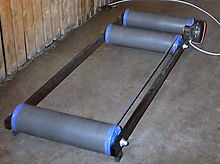Free role
As a free roll , also free, unbraked roll or (English and as a product name) roller track is a training tool in cycling that simulates cycling without having to move from the spot. Expressions such as training roller and roller trainer , which used to be synonyms for the free roller , are now used as a collective term for various devices, in particular those with a bicycle lock .
The free roller consists of three metal or plastic rollers about 50 cm wide, which are installed in a metal frame so that they can rotate freely in such a way that a racing bike with the rear wheel can safely be placed between the two rear rollers and the front wheel just behind the front roller finds (see figures). In contrast to the usual training role today, the bicycle is not attached, but only set up and maintains a dynamic balance due to the gyroscopic forces of the rotating wheels and the steering movements of the rider.
Types of exercise rollers and exercise bikes
The free roller is just one type of sports equipment that is used to simulate cycling . The following devices are common:
- Fitness ergometer with and without a flywheel and with different braking devices
- Ergometer for scientifically based tests with and without a flywheel and with different braking devices
- Spinning bikes with a flywheel and braking device
- the free roll with and without braking device and without any noteworthy flywheel
- Training rollers with attachment options for the bicycle with different braking devices.
Technical features of the free role
The rider and the bike are kept upright on the free roller due to the gyroscopic forces. This requires a minimum speed of around 20 km / h or around 160 wheel revolutions per minute. In order to generate the required gyroscopic forces and to make the bicycle controllable, the rotation is transmitted by a drive belt from the front of the two rear rollers to the front roller. The front roller sets the front wheel in rotation so that it unfolds its stabilizing gyroscopic forces. Feet on the frame of the roller ensure a safe stand and prevent unintentional braking of the rollers by dragging on the floor.
Braking devices on a free roller are rather uncommon, but available. Braking devices may slow down the drive on the free roller so much that the above-mentioned. critical minimum speed is not reached.
Skill of the driver
Since the dynamic stabilization forces that occur with the free roller are different from driving on the road and rail, steering on the free roller requires a certain amount of getting used to. Overall, the driver is in a more unstable state with the bike, the bike reacts more nervously to steering movements.
Functions of the free role in training
Because of the greater dexterity to be applied, the free role is initially used as a means to support driving technique. People like to work with high cadence . At the same time, the free role therefore also serves to train the round step . However, the paramount importance that the free role, especially as a training tool in track cycling, still had up to the 1980s, has to be put into perspective. On the one hand, low cadence and high force have their positive effects on the "round step", on the other hand, the most important property of both free rollers and those with mounting options for the bicycle is the lack of moving, inert mass (system weight of bicycle and rider or flywheel as with a spinning bike ).
As there is no momentum, the rider is not “helped over” the irregularities in the development of force during the free roll - he has to eliminate them himself through improved muscle coordination.
Above all, the free roll contributes to the development of the round step when - as is usual in track cycling - you ride on it with a rigid gear . Due to the lack of freewheel, the bike reacts with an uneven step with a swinging back and forth swinging, which has a destabilizing effect even at medium cadence and encourages the rider to improve his pedaling technique.
Another function of the free role in track cycling is that the riders cannot warm up on the track (there are usually other competitions running there). But also for this purpose, the free roller is gradually being replaced by rollers with a fastening and braking device.
Advantages and disadvantages of the free role
The disadvantage of the free castor, like almost all types with wheel attachment, is the lack of a flywheel. While this can even be an advantage for training methodological reasons (see above), the driver perceives it as a lack of realism. Furthermore, with the free roll, driving while standing is almost impossible.
The free roll clearly has its advantages in the halfway realistic simulation of high-frequency pedaling on the track, which is why it was least displaced there by the roll with attachment. When training the maximum cadence while maintaining the driving line, it is still almost indispensable for track sprinters today . Railway sprinters should achieve cadence between 220 and 250 / min on this device (for comparison: road drivers usually reach maximum frequencies of 170 to 200 / min).

